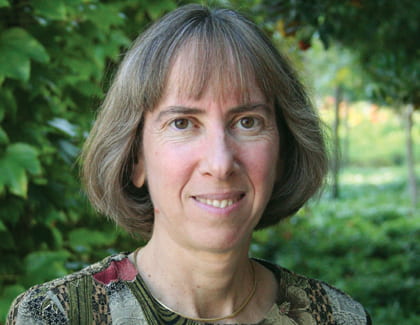Keeping secrets
Math professor Alice Silverberg specializes in cryptography – creating codes to safeguard information

Cryptography – the science of creating codes – often conjures up images of World War II military spies, mysterious religious sects,The Da Vinci Code and other tales of intrigue.
Underlying true and fictional stories about secret messages are mathematical formulas. That’s where Alice Silverberg comes in.
Silverberg, UCI professor of mathematics and computer science, specializes in number theory and cryptography. She’s not tapping out secret messages on a decoder ring. She’s helping people safeguard information by designing more efficient and secure cryptosystems and using mathematics to better understand them.
Silverberg will discuss “Cryptography: How to Keep a Secret” as a featured speaker in the 10th Annual Discover the Physical Sciences Breakfast Lecture Series 7:30-9 a.m. Tuesday, April 1, in the University Club. (R.S.V.P. by March 18 toevents@ps.uci.edu or 949-824-7252.)
Cryptography itself is an ancient science. Julius Caesar communicated to his generals using a secret code. Each letter in his plain-text message was replaced by a letter three positions down the alphabet; that became known as the Caesar cipher.
In today’s digital age, complex mathematical puzzles make it possible for people to keep eavesdroppers from listening to their cell phone conversations or capturing their credit card information over the Internet. In the mid-1980s, mathematicians discovered that a certain branch of number theory called elliptic curves could be used to encrypt messages. Silverberg – who was already studying elliptic curves – developed an interest in cryptography.
While her interest in codes is academic, Silverberg is not immune to the allure of hidden messages and concealed meanings. She spent several months as a consultant to the TV show Numb3rs, about an FBI agent who recruits his mathematical genius brother to help solve crimes. For one episode, Silverberg was asked to come up with math equations they could reproduce on a blackboard. She sent them formulas embedded with some text: CEILIDH – the acronym for a cryptosystem created with a colleague, and the name of her late cat.
“My cat’s name flashed across the screen and was seen by over 12 million viewers,” she says.
Silverberg, who earned her doctorate in mathematics from Princeton University, prefers the real-life intrigue of mathematics to television fiction.
“Studying number theory is like solving a puzzle. There are many questions you want to answer,” she says. “You want to understand numbers, because they’re a key to mathematics, the world, the universe.”
